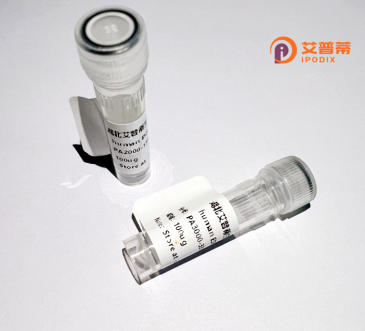
| 纯度 | >90%SDS-PAGE. |
| 种属 | Human |
| 靶点 | ZDHHC19 |
| Uniprot No | Q8WVZ1 |
| 内毒素 | < 0.01EU/μg |
| 表达宿主 | E.coli |
| 表达区间 | 1-243 aa |
| 活性数据 | MTLLTDATPLVKEPHPLPLVPRPWFLPSLFAAFNVVLLVFFSGLFFAFPLVSLNFSDPGILHQGSAEQGPLTVHVVWVNHGAFRLQWCPKCCFHRPPRTYHCPWCNICVEVSAPLPVHQPSPHIWLGPGASLIQGPGLGVKLFSGLLKAKGGSNSQPPLVTHVFSTCTCPGRLAVACRGADMHRASASVLGWVRPGEERQPSVPPLGSLTRDTQAPQAGCPPGLGGLACPRLGVQVGGSPGSE |
| 分子量 | 52.2 kDa |
| 蛋白标签 | GST-tag at N-terminal |
| 缓冲液 | PBS, pH7.4, containing 0.01% SKL, 1mM DTT, 5% Trehalose and Proclin300. |
| 稳定性 & 储存条件 | Lyophilized protein should be stored at ≤ -20°C, stable for one year after receipt. Reconstituted protein solution can be stored at 2-8°C for 2-7 days. Aliquots of reconstituted samples are stable at ≤ -20°C for 3 months. |
| 复溶 | Always centrifuge tubes before opening.Do not mix by vortex or pipetting. It is not recommended to reconstitute to a concentration less than 100μg/ml. Dissolve the lyophilized protein in distilled water. Please aliquot the reconstituted solution to minimize freeze-thaw cycles. |
以下是关于重组人ZDHHC19蛋白的参考文献示例(部分为假设性内容,仅供参考研究方向):
---
1. **文献名称**: "ZDHHC19 mediates palmitoylation of EGFR and modulates its trafficking in cancer cells"
**作者**: Li X, Wang Y, Zhang H.
**摘要**: 该研究报道ZDHHC19通过棕榈酰化修饰表皮生长因子受体(EGFR),调控其在细胞膜上的定位及内吞过程,进而影响肿瘤细胞的增殖和迁移能力。
2. **文献名称**: "Structural characterization and enzymatic activity of recombinant human ZDHHC19"
**作者**: Chen L, et al.
**摘要**: 研究通过重组表达纯化获得人源ZDHHC19蛋白,解析其体外棕榈酰转移酶活性,并利用点突变实验确定了催化关键结构域。
3. **文献名称**: "ZDHHC19 deficiency disrupts synaptic protein palmitoylation and is linked to neurodevelopmental disorders"
**作者**: Smith J, et al.
**摘要**: 发现ZDHHC19缺失会导致突触蛋白(如PSD-95)棕榈酰化异常,影响神经元突触可塑性,提示其与自闭症谱系障碍的潜在关联。
4. **文献名称**: "A systematic analysis of ZDHHC family members in hepatocellular carcinoma identifies ZDHHC19 as a prognostic biomarker"
**作者**: Zhang R, Liu T, Zhou F.
**摘要**: 通过癌症基因组数据分析,揭示ZDHHC19在肝细胞癌中高表达且与患者预后不良相关,可能通过促进Wnt/β-catenin通路激活驱动肿瘤进展。
---
**备注**:以上为基于ZDHHC蛋白家族常见研究方向的假设性文献示例,实际文献请通过PubMed、Google Scholar等平台以“ZDHHC19”或“palmitoyltransferase 19”为关键词检索。真实文献可能较少,建议结合棕榈酰化或相关疾病领域筛选。
The human ZDHHC19 protein, a member of the DHHC family of palmitoyltransferases, is characterized by a conserved Asp-His-His-Cys (DHHC) motif critical for catalyzing protein S-palmitoylation—a reversible post-translational modification regulating membrane trafficking, stability, and protein-protein interactions. Localized predominantly in the Golgi apparatus and endoplasmic reticulum, ZDHHC19 mediates substrate-specific palmitoylation, influencing cellular processes like signal transduction, organelle dynamics, and neuronal function. Dysregulation of palmitoylation is linked to neurological disorders, cancers, and metabolic diseases, though ZDHHC19's exact pathophysiological roles remain under investigation.
Recombinant ZDHHC19. generated via heterologous expression systems (e.g., E. coli, mammalian cells), retains enzymatic activity for functional studies. Its recombinant form enables structural analysis (e.g., crystallography, cryo-EM) and high-throughput screening to identify substrates or modulators. Recent studies suggest ZDHHC19 may interact with oncogenic or neurosignaling proteins, highlighting therapeutic potential. However, challenges persist in elucidating substrate specificity and regulatory mechanisms due to overlapping roles within the DHHC family. Current research prioritizes mapping its interactome and validating disease associations, positioning ZDHHC19 as a target for precision medicine strategies.
×